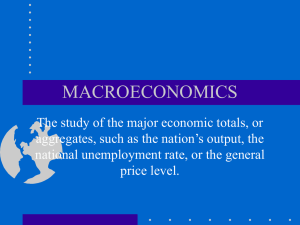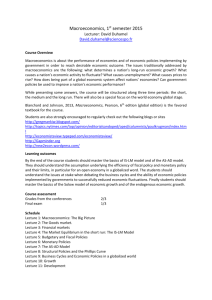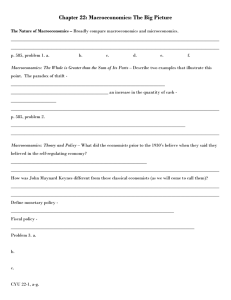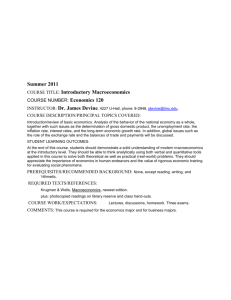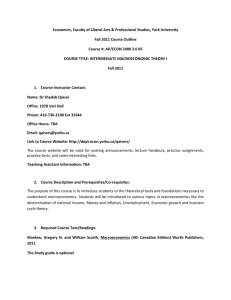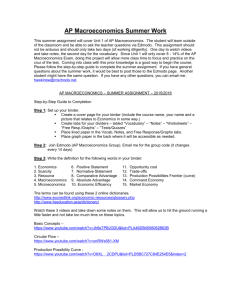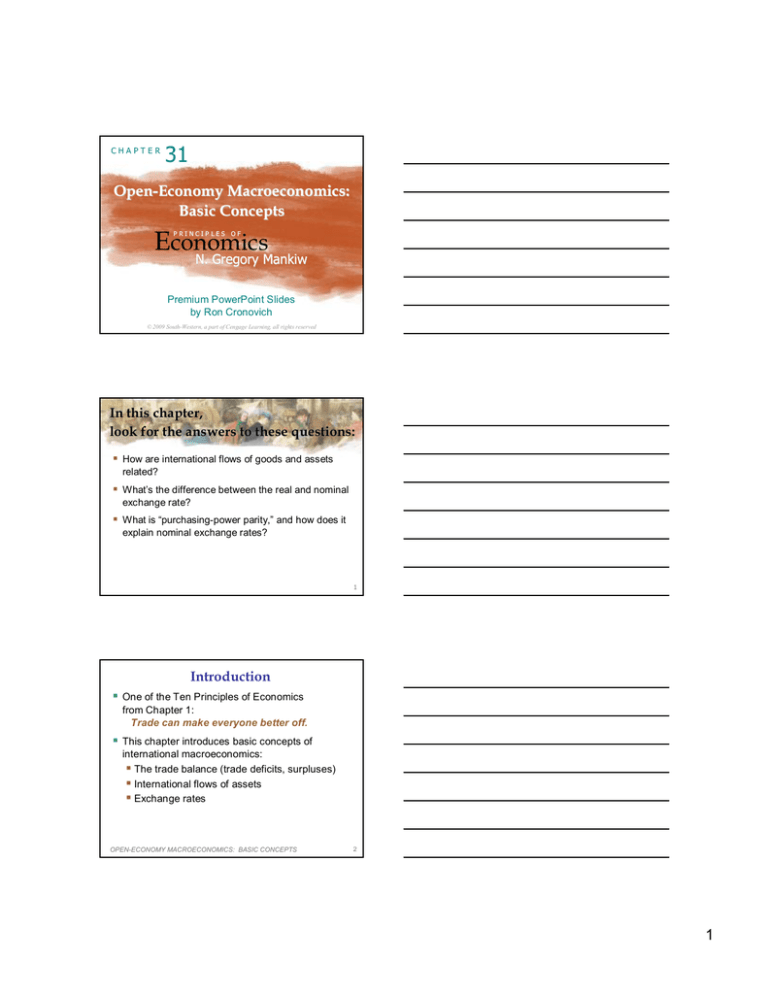
CHAPTER
31
OpenOpen-Economy Macroeconomics:
Basic Concepts
Economics
P RINCIP LES OF
N. Gregory Mankiw
Premium PowerPoint Slides
by Ron Cronovich
© 2009 South-Western, a part of Cengage Learning, all rights reserved
In this chapter,
look for the answers to these questions:
§ How are international flows of goods and assets
related?
§ What’s the difference between the real and nominal
exchange rate?
§ What is “purchasing-power parity,” and how does it
explain nominal exchange rates?
1
Introduction
§ One of the Ten Principles of Economics
from Chapter 1:
Trade can make everyone better off.
§ This chapter introduces basic concepts of
international macroeconomics:
§ The trade balance (trade deficits, surpluses)
§ International flows of assets
§ Exchange rates
OPEN-ECONOMY MACROECONOMICS: BASIC CONCEPTS
2
1
Closed vs. Open Economies
§ A closed economy does not interact with other
economies in the world.
§
OPEN-ECONOMY MACROECONOMICS: BASIC CONCEPTS
3
The Flow of Goods & Services
§ Exports:
domestically-produced g&s sold abroad
§ Imports:
foreign-produced g&s sold domestically
§
OPEN-ECONOMY MACROECONOMICS: BASIC CONCEPTS
4
ACTIVE LEARNING 1
Variables that affect NX
What do you think would happen to
U.S. net exports if:
A. Canada experiences a recession
(falling incomes, rising unemployment)
B. U.S. consumers decide to be patriotic and
buy more products “Made in the U.S.A.”
C. Prices of goods produced in Mexico rise faster
than prices of goods produced in the U.S.
5
2
ACTIVE LEARNING 1
Answers
6
Variables that Influence Net Exports
§ Consumers’ preferences for foreign and
domestic goods
§
§
§
§ Transportation costs
§ Govt policies
OPEN-ECONOMY MACROECONOMICS: BASIC CONCEPTS
8
Trade Surpluses & Deficits
NX measures the imbalance in a country’s trade in
goods and services.
§ Trade deficit:
§ Trade surplus:
§ Balanced trade:
OPEN-ECONOMY MACROECONOMICS: BASIC CONCEPTS
9
3
The U.S. Economy’s Increasing Openness
Imports
Exports
The Flow of Capital
§ Net capital outflow (NCO):
§ NCO is also called
OPEN-ECONOMY MACROECONOMICS: BASIC CONCEPTS
11
The Flow of Capital
The flow of capital abroad takes two forms:
§ Foreign direct investment:
Domestic residents actively manage the foreign
investment, e.g., McDonalds opens a fast-food
outlet in Moscow.
§ Foreign portfolio investment:
Domestic residents
OPEN-ECONOMY MACROECONOMICS: BASIC CONCEPTS
12
4
The Flow of Capital
NCO measures the imbalance in a country’s trade
in assets:
§ When NCO > 0,
§ When NCO < 0,
Foreign purchases of domestic assets exceed
domestic purchases of foreign assets.
OPEN-ECONOMY MACROECONOMICS: BASIC CONCEPTS
13
Variables that Influence NCO
§
§
§
§ Govt policies affecting foreign ownership of
domestic assets
OPEN-ECONOMY MACROECONOMICS: BASIC CONCEPTS
14
The Equality of NX and NCO
§ An accounting identity:
§ arises because every transaction that affects
NX also affects NCO by the same amount
(and vice versa)
OPEN-ECONOMY MACROECONOMICS: BASIC CONCEPTS
15
5
Saving, Investment, and International
Flows of Goods & Assets
Y = C + I + G + NX
accounting identity
rearranging terms
since S = Y – C – G
since NX = NCO
§ When S > I,
§ When S < I,
17
OPEN-ECONOMY MACROECONOMICS: BASIC CONCEPTS
Case Study: The U.S. Trade Deficit
§ The U.S. trade deficit reached record levels in
2006 and remained high in 2007-2008.
§ Recall, NX = S – I = NCO.
A trade deficit means
§ In 2007, foreign purchases of U.S. assets
exceeded U.S. purchases of foreign assets by
$775 million.
§ Such deficits have been the norm since 1980…
18
OPEN-ECONOMY MACROECONOMICS: BASIC CONCEPTS
U.S. Saving, Investment, and NCO, 1950-2007
(% of GDP)
Investment
Saving
NCO
6
Case Study: The U.S. Trade Deficit
Why U.S. saving has been less than investment:
§ In the 1980s and early 2000s,
§ In the 1990s,
national saving increased as the economy grew,
but domestic investment
OPEN-ECONOMY MACROECONOMICS: BASIC CONCEPTS
20
Case Study: The U.S. Trade Deficit
§ Is the U.S. trade deficit a problem?
§ The extra capital stock from the ’90s investment
boom may well yield large returns.
§ The fall in saving of the ’80s and ’00s,
while not desirable, at least did not depress
domestic investment, as firms could borrow
from abroad.
§ A country, like a person, can go into debt
for good reasons or bad ones.
A trade deficit is not necessarily a problem,
but might be a symptom of a problem.
OPEN-ECONOMY MACROECONOMICS: BASIC CONCEPTS
21
Case Study: The U.S. Trade Deficit
as of 12-31-2007
People abroad owned $20.1 trillion in U.S. assets.
U.S. residents owned $17.6 trillion in foreign assets.
U.S.’ net indebtedness to other countries = $2.5 trillion.
Higher than every other country’s net indebtedness.
So,
§ So far, the U.S. earns higher interest rates on foreign
assets than it pays on its debts to foreigners.
§ But if U.S. debt continues to grow, foreigners may
demand higher interest rates, and servicing the debt
would become a drain on U.S. income.
OPEN-ECONOMY MACROECONOMICS: BASIC CONCEPTS
22
7
The Nominal Exchange Rate
§ Nominal exchange rate:
§ We express all exchange rates as foreign
currency per unit of domestic currency.
OPEN-ECONOMY MACROECONOMICS: BASIC CONCEPTS
23
Appreciation and Depreciation
§ Appreciation (or “strengthening”):
as measured by the amount of foreign currency
it can buy
§ Depreciation (or “weakening”):
as measured by the amount of foreign currency
it can buy
§ Examples: During 2007, the U.S. dollar…
§ depreciated 9.5% against the Euro
§ appreciated 1.5% against the S. Korean Won
The Real Exchange Rate
§ Real exchange rate:
§ Real exchange rate =
where
P =
P* = foreign price (in foreign currency)
e = nominal exchange rate, i.e., foreign
currency per unit of domestic currency
OPEN-ECONOMY MACROECONOMICS: BASIC CONCEPTS
25
8
Example With One Good
§ A Big Mac costs $2.50 in U.S., 400 yen in Japan
§ e = 120 yen per $
§ exP=
§ Compute the real exchange rate:
exP
=
P*
yen per U.S. Big Mac
yen per Japanese Big Mac
=
OPEN-ECONOMY MACROECONOMICS: BASIC CONCEPTS
26
Interpreting the Real Exchange Rate
“The real exchange rate =
0.75 Japanese Big Macs per U.S. Big Mac”
Correct interpretation:
OPEN-ECONOMY MACROECONOMICS: BASIC CONCEPTS
27
ACTIVE LEARNING 2
Compute a real exchange rate
e = 10 pesos per $
price of a tall Starbucks Latte
P = $3 in U.S., P* = 24 pesos in Mexico
A. What is the price of a US latte measured in
pesos?
B. Calculate the real exchange rate,
measured as Mexican lattes per US latte.
28
9
The Real Exchange Rate With Many Goods
P=
measures the price of a basket of goods
P* =
Real exchange rate
= (e x P)/P*
=
§ If U.S. real exchange rate appreciates,
OPEN-ECONOMY MACROECONOMICS: BASIC CONCEPTS
30
The Law of One Price
§ Law of one price:
§ Suppose coffee sells for $4/pound in Seattle
and $5/pound in Boston,
and can be costlessly transported.
§ There is an opportunity for _______________ ,
making a quick profit by buying coffee in
Seattle and selling it in Boston.
§
OPEN-ECONOMY MACROECONOMICS: BASIC CONCEPTS
31
Purchasing-Power Parity (PPP)
§ Purchasing-power parity:
§ based on the law of one price
§ implies that
OPEN-ECONOMY MACROECONOMICS: BASIC CONCEPTS
32
10
Purchasing-Power Parity (PPP)
§ Example: The “basket” contains a Big Mac.
P = price of US Big Mac (in dollars)
P* = price of Japanese Big Mac (in yen)
e = exchange rate, yen per dollar
§ According to PPP,
§ Solve for e:
OPEN-ECONOMY MACROECONOMICS: BASIC CONCEPTS
33
PPP and Its Implications
§ PPP implies
§ If the two countries have different inflation rates,
then
§ If inflation is higher in Mexico than in the U.S.,
§ If inflation is higher in the U.S. than in Japan,
then P rises faster than P*, so e falls –
the dollar depreciates against the yen.
OPEN-ECONOMY MACROECONOMICS: BASIC CONCEPTS
34
Limitations of PPP Theory
Two reasons why exchange rates do not always
adjust to equalize prices across countries:
§
§ Examples: haircuts, going to the movies
§
§
§ E.g., some U.S. consumers prefer Toyotas over
Chevys, or vice versa
§
OPEN-ECONOMY MACROECONOMICS: BASIC CONCEPTS
35
11
Limitations of PPP Theory
§ Nonetheless, PPP works well in many cases,
especially as an explanation of long-run trends.
§ For example, PPP implies:
(relative to a low-inflation country like the US).
§ The data support this prediction…
36
OPEN-ECONOMY MACROECONOMICS: BASIC CONCEPTS
Inflation & Depreciation in a Cross-Section
of 31 Countries
10,000.0
Ukraine
1,000.0
Avg annual
depreciation 100.0
relative to
10.0
US dollar
1993-2003
1.0
(log scale)
0.1
Romania
Brazil
Argentina
Mexico
Canada
Kenya
Japan
0.1
1.0
10.0 100.0 1,000.0
Avg annual CPI inflation
1993-2003 (log scale)
ACTIVE LEARNING 3
Chapter review questions
1. Which of the following statements about a country
with a trade deficit is not true?
A. Exports < imports
B. Net capital outflow < 0
C. Investment < saving
D. Y < C + I + G
2. A Ford Escape SUV sells for $24,000 in the U.S.
and 720,000 rubles in Russia.
If purchasing-power parity holds, what is the
nominal exchange rate (rubles per dollar)?
38
12

